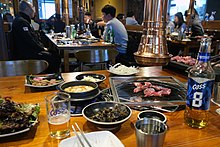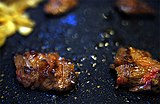| Korean barbecue | |
 Galbi Galbi | |
| Korean name | |
|---|---|
| Hangul | 고기구이 |
| Revised Romanization | gogigui |
| McCune–Reischauer | kogigui |
Korean barbecue (Korean: 고기구이, gogi-gui, 'meat roast') is a popular method in Korean cuisine of grilling meat, typically beef, pork or chicken. Such dishes are often prepared on gas or charcoal grills built into the dining table itself, though some restaurants provide customers with portable stoves for diners to use at their tables. Alternatively, a chef uses a centrally displayed grill to prepare dishes that are made to order.
The most representative form of gogi-gui is bulgogi, usually made from thinly sliced marinated beef sirloin or tenderloin. Another popular form is galbi, made from marinated beef short ribs. However, gogi-gui also includes many other kinds of marinated and unmarinated meat dishes, and can be divided into several categories. Korean barbecue is popular in its home country. It gained its global popularity through Hallyu, more commonly known as the "Korean Wave", a term that describes the rise in popularity of Korean culture during the 1990s and 2000s.
History
See also: History of Korean cuisine
Maekjeok (Korean: 맥적; Hanja: 貊炙) from Goguryeo era (37 BCE–668 CE) is the oldest record related to Korean barbecue. During the Joseon dynasty (1392–1910), roasted beef Neobiani was a favorite of the Joseon royal family.
Korean barbecue spread to Japan around the 1910–1945 Japanese colonial period. It was adapted to Japanese tastes, and now persists today as yakiniku.
Varieties
See also: Cut of beef § Korean| Meat | Marinated | Unmarinated |
|---|---|---|
| Beef |
|
|
| Pork |
|
|
| Chicken |
|
|
| Duck |
|
|
Marinated barbecue meats
Bulgogi (불고기) is the most popular variety of Korean barbecue. Before cooking, the meat is marinated with a mixture of soy sauce, sugar, ginger, scallions, sesame oil, garlic and pepper. Pears are also traditionally used in the marinade to help tenderize the meat, but kiwi and pineapple have also been used more recently. It is traditionally cooked using gridirons or perforated dome griddles that sit on braziers, but pan cooking has become common as well.

Galbi (갈비) is made with beef short ribs, marinated in a sauce that may contain mirin, soy sauce, water, garlic, brown sugar, sugar and sliced onions. It is believed to taste best when grilled with charcoal or soot (숯, burned wood chips).
Jumulleok (주물럭) is short steak marinated with sesame oil, salt and pepper. It is similar to unmarinated gogi-gui, distinguished it from other kinds of meat by its steak-like juicy texture. Jumulleok is also commonly found with sliced duck instead of beef.
Dwaeji bulgogi (돼지불고기), or spicy pork, is also a popular gogigui dish. It is different from beef bulgogi in that the marinade is not soy sauce-based, but, instead, is marinated in sauces based on gochujang and/or gochu garu (Korean chili powder). The flavor is usually better when made with fattier cuts of pork, such as pork shoulder or pork belly.
Un-marinated barbecue meats

Chadolbagi or chadolbaegi is a dish made from thinly sliced beef brisket, which is not marinated. It is so thin that it cooks nearly instantly as soon as it is dropped onto a heated pan.
Samgyeopsal is made of thicker strips of unsalted pork belly. It has fatty areas and is tender. In Korea, samgyeopsal is eaten more frequently than chadolbaegi due to the comparatively lower price of pork.

Loins (deungsim, 등심) and boneless ribs (galbisal, 갈비살) are also a popular choice as an unmarinated type of gogigui.
Side dishes
Gogi-gui comes with various banchan (side dishes). The most popular side dishes are rice and kimchi, and a green onion salad called pajeori and a fresh vegetable dish including lettuce, cucumbers, and peppers invariably accompany the meat dishes at restaurants. Other popular side dishes include the spinach side dish (sigeumchi namul/시금치나물), egg roll omelette (gyeran-mari/계란말이), spicy radish salad (mu saengchae/무생채), and a steamed egg soufflé (gyeran-jjim/계란찜). A popular way of eating Korean barbecue is to wrap the meat with lettuce and/or perilla leaves and add condiments such as pajeori (spicy scallion salad) and ssamjang (a spicy paste made of doenjang mixed with gochujang).
Korean barbecue is also popularly paired with alcoholic drinks, such as beer, soju, makgeolli, or wine.
Gallery
Korean barbecue dishes-
 Galbi cooking
Galbi cooking
-
 Fresh cut loins and boneless ribs
Fresh cut loins and boneless ribs
-
 Marinated boneless galbi
Marinated boneless galbi
-
 Korean barbecue
Korean barbecue
-
 Galbisal, boneless ribs before cooking
Galbisal, boneless ribs before cooking
-
 Barbecued galbisal after cooking
Barbecued galbisal after cooking
-
 Pajeori (파절이), a banchan of spicy green onion salad
Pajeori (파절이), a banchan of spicy green onion salad
See also
References
- Notes
- Although beef galbi is the most common form of galbi, it may also be made from pork ribs or chicken.
- "Where Did KBBQ Come From? Inside Its 2,000-Year-Old History". Nextshark. 21 December 2020.
- Weiner, Michael (2004). Race, Ethnicity and Migration in Modern Japan: Indigenous and colonial others. Taylor & Francis. p. 236. ISBN 978-0-415-20856-7.
Yakiniku is a Japanese word simply meaning "cooked meat" and used to denote a grilled meat cuisine found in Korean restaurants in Japan. The mainland Korean equivalent is bulgogi but the two cuisines are not entirely the same. Yakuniku is a variant of cooked meat that has been modified by Zainichi Koreans to appeal to Japanese tastes.
- "「焼肉」名前の由来とは... え、朝鮮半島の南北対立が背景なの?【焼肉の日】". ハフポスト (in Japanese). 2016-08-29. Retrieved 2021-11-09.
- "Bulgogi (Korean Barbecued Beef)". Food Network. Retrieved 2021-03-27.
- Paley, Rachel Tepper (30 December 2015). "A Brief History of Bulgogi, Korea's Most Delicious Export (Recipe)". Smithsonian Magazine. Retrieved 2021-03-27.
- Kang, Matthew. "Watch: How to Do All-You-Can-Eat Korean Barbecue Like a Pro". Eater. Retrieved 2018-03-30.
- "Grilled Beef Galbi (Korean-Style Marinated Short Ribs) Recipe". www.seriouseats.com. Retrieved 2021-03-27.
- ^ Marx, Sasha. "An Introduction to Korean Barbecue". Serious Eats. Retrieved 2021-03-27.
- Marx, Sasha. "Dwaeji Bulgogi (Korean-Style Spicy Grilled Pork) Recipe". Serious Eats. Retrieved 2021-03-27.
- Sung, Andrea (2016-10-17). "Beyond Kimchi, The Rich Variety of Side Dishes in Korean Cuisine". KCET. Retrieved 2021-03-26.
- Kastner, Erica (2018-09-20). "5 Easy Korean Side Dishes". The Pioneer Woman. Retrieved 2021-03-26.
- Kim, Sohui (12 February 2019). "Dashi-Steamed Egg Custard". Bon Appétit. Retrieved 2021-03-26.
- Sources
- 구이 (in Korean). Doosan Encyclopedia. Retrieved 2017-03-08.
- 구이 (in Korean). Encyclopedia of Korean Culture. Retrieved 2017-03-08.
- 구이 (in Korean). Empas/Encyclopædia Britannica. Retrieved 2008-03-15.
External links
- How to Cook Korean Food at Home Archived 2008-04-20 at the Wayback Machine - The Official Korea Tourism Guide Site